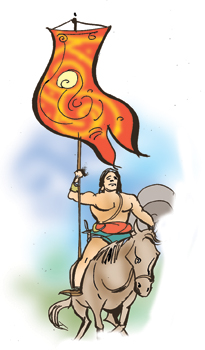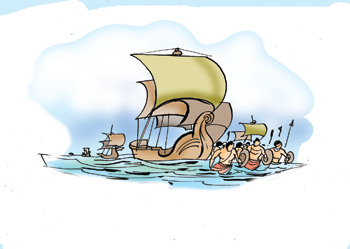
The end of Lankapura~This article is part of a continuing series on the ‘Mahavamsa,’ the recorded chronicle of Sri Lankan history~
2. Inscriptions contain better details. The first inscription about this war, is written two years after Commander Lankapura landed in the Pandya country. According to this inscription, the Sinhala army had captured the Pandya country and chased away Prince Kulasekera from the city of Madhura. There were serious battles in places like Thondi and Pasi which were under Chola rulers. The Sinhala army has been successful in capturing these places. 3. The people of the Chola country were quite frightened over this fighting. As a result of this, there appeared a holy person to their rescue. This was a miraculous intervention. Religious ceremonies were held and there was continuous praying – for 21 full days. According to them, at the end of 21 days, the Sinhala forces were completely defeated. These inscriptions contain random references to events that appear in our chronicles too.
5. Some historians feel that once the Cholas intensified their intervention, the fighting would have become so severe, that the Sinhala armies found it difficult to face the situation. The second Chola inscription is written in 1174 AD. According to that, Prince Kulasekera had gone to the Chola country. He went there seeking their help, to regain his throne, that was wrested from him, by the Sinhala army. 6. The Chola ruler readily consented and offered help. The Chola armies came to Madhura. They fought many a battle and recorded victories. Dandanatha and Lankapura were both defeated. The Chola soldiers killed the Sinhala commanders. Their heads were nailed to the gates of the city of Madhura. After that Prince Kulasekera, became the ruler of Madhura once more. Consequently the Pandya kingdom never became a dependency of Sri Lanka.
8. All the Chola inscriptions contain very short descriptions of the first battles. They refer to how King Parakramabahu continued ship-building in places like Kayts, Mantai, Valikamam and other such places. They also contain reference to how the king had recruited men to the army. All this had been done, with the intention of making another South Indian invasion.
|
|| Front
Page | News | Editorial | Columns | Sports | Plus | Financial
Times | International | Mirror | TV
Times | Funday
Times || |
| |
Reproduction of articles permitted when used without any alterations to contents and the source. |
© Copyright
2008 | Wijeya
Newspapers Ltd.Colombo. Sri Lanka. All Rights Reserved. |
 1. Some historians say, that they cannot have full faith in what our chronicles record. This doubt of course, is not unfounded. If Prince
Kulase-kera was so weak as our chronicles record, he could not have organized such powerful armies. Moreover, he would not have come to fight over and over again. Even the Chola records that describe these battles are partial. Some of them are contradictory. The Chulavamsa is not clear about the end of the fight between the Sinhala forces and Prince Kulasekera.
1. Some historians say, that they cannot have full faith in what our chronicles record. This doubt of course, is not unfounded. If Prince
Kulase-kera was so weak as our chronicles record, he could not have organized such powerful armies. Moreover, he would not have come to fight over and over again. Even the Chola records that describe these battles are partial. Some of them are contradictory. The Chulavamsa is not clear about the end of the fight between the Sinhala forces and Prince Kulasekera. 4. However, there is contradiction over the end of this fight. Even after the end of fighting described in the Chulavamsa, the Chola records mention the continuation of the war. It may be that our chronicler gave an abrupt end to the description of the war because he wanted to stop it with the victory of the Sinhala forces. Therefore, the defeat and death of Lankapura was kept a secret. However, once the Cholas were angered they entered into direct fighting.
4. However, there is contradiction over the end of this fight. Even after the end of fighting described in the Chulavamsa, the Chola records mention the continuation of the war. It may be that our chronicler gave an abrupt end to the description of the war because he wanted to stop it with the victory of the Sinhala forces. Therefore, the defeat and death of Lankapura was kept a secret. However, once the Cholas were angered they entered into direct fighting. 7. This inscription was written after the death of the Chola commander who killed Lankapura. Even after the death of commanders like Lankapura and Jagath Vijaya, the fighting did not stop. The Sinhala army entertained the wish to conquer the Pandya country. King Parakramabahu too extended his support for this attempt. This is recorded in the inscriptions written somewhere around 1178 AD.
7. This inscription was written after the death of the Chola commander who killed Lankapura. Even after the death of commanders like Lankapura and Jagath Vijaya, the fighting did not stop. The Sinhala army entertained the wish to conquer the Pandya country. King Parakramabahu too extended his support for this attempt. This is recorded in the inscriptions written somewhere around 1178 AD.